

Leading Change: Creating a Sense of Urgency (Step 1) Back to Top What is a Sense of Urgency The results of an IBM Global Study, The Enterprise of the Future, show organizations are flooded with change and many are finding it hard to keep up.

Like many organizational realities, the flood of change organizations face brings both good and bad news. The bad news is that the rapid rate of change will not subside. It will only increase. I will address each of his eight steps in separate articles. So, what is a sense of urgency? Two explanations of the word urgency are useful for understanding what leaders do as agents of change: First, leaders take actions that capture the attention of critical organizational stakeholders.Second, leaders explain the importance of making speedy changes to the existing condition. When leaders create a sense of urgency, they alert the organization that change must occur and the leaders also begin preparing the organization for the change process. Leaders, Stop Trying to Be Heroes. LinkedIn by Dr. David Weiss. Leadership in Complexity and Change: For a World in Constant Motion (25 October 2021) by Sharon Varney.
Book Summary: The Leader's Guide to Unconscious Bias by Pamela Fuller et al. Imagine a help-wanted advertisement specifying that candidates must be right-handed, brown-haired and more than six feet tall.
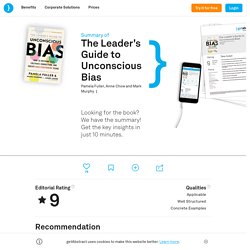
According to authors Pamela Fuller, Anne Chow and Mark Murphy, preferences like these actually do play a significant role in your judgments. Because biases are unconscious, you won’t realize you’re making hiring decisions based on assumptions that may be irrelevant, unfair or untrue. The authors explain how to become aware of your biases and then outline strategies for circumventing them. On-demand webinar: Fueling the Ambition to Be a Leader of Change. A transactional approach to power. Transactional has become something of a dirty word in the business world.
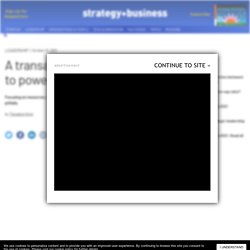
It suggests a short-term, one-off mindset and a commoditized approach to value. Nobody wants transactional relationships with employees, suppliers, or customers. But when it comes to exercising power, understanding power as a transaction may be a leader’s best bet. That’s because power is something leaders are commonly thought to possess, either by force of personality or by dint of positional authority. The mistaken idea that you are inherently powerful can be extraordinarily seductive—and comes with a variety of leadership pitfalls. There are lots of worthy prescriptions for avoiding the pitfalls of power, including servant, humble, and empathic leadership. Like Emerson, Battilana and Casciaro peg power to resources, not people. Both leaders and followers have power simply by virtue of having something that the other wants. Although power is distributed, it is rarely balanced. Comment piloter le changement : la courbe du changement. Confidently Lead Your Next Change Initiative.
Strategy Activation Bootcamp is designed with busy professionals in mind and covers a lot of ground in three short days.
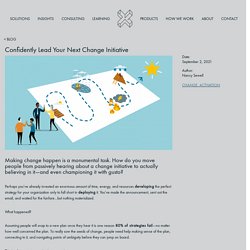
It’s a fast-paced course that balances expert instruction with hands-on practical application and peer-to-peer learning. Participants acquire the tools and knowledge to bring their strategies to life by aligning, equipping, and activating their people to adopt change. The course explores a theory of change, a diagnostic tool to assess the efforts required, and a practical system to create change programs that stick. By the end of Strategy Activation Bootcamp, you’ll be able to: Leadership In an Era of Change Fatigue. PDR’s Julie Fuex explains how leadership that proactively plans for change fatigue will find that the effort invested reaps significant rewards.
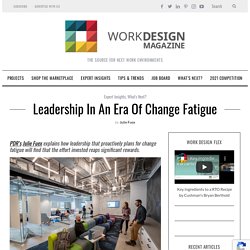
This year brought new hope for an end to the pandemic and a return to normalcy, but the rise of the Delta variant put a wrench in many organizations’ return to the office or future of work efforts. While this can seem like another roadblock to getting back to normal, it is also an opportunity for leaders to rethink the future of work and adjust their change fatigue and management approach to fit within the current moment. No longer can leaders charge forward with bold change initiatives and expect people to be inspired to follow. What people need right now is stability, clarity, empathy, compassion, and support. No longer can leaders charge forward with bold change initiatives and expect people to be inspired to follow. Before jumping into the return to office planning, take a moment to acknowledge how harrowing the past 18 months have been.
Tools for Coaching, Leadership and Change Management: A Most Complete Compendium of Tools and Techniques for Working Smarter with People (11 October 2021) by Nicolai Andler. Leadership 2.0: Gain New Skills to Meet New Challenges. Wharton@Work Nano Tools for Leaders® are fast, effective leadership tools that you can learn and start using in less than 15 minutes — with the potential to significantly impact your success as a leader and the engagement and productivity of the people you lead.

The Goal. The Secret to Leading Organizational Change Is Empathy. To Inspire Your Team, Share More of Yourself. Research: Informal Leadership Comes at a Cost. Podcast: Curve Benders: A New Perspective on the Role of Change Practitioner and Change Leader, With David Nour. Podcast: Play in new window | Download Subscribe: Apple Podcasts | In this podcast, Managing Editor Brian Gorman talks with David Nour about the interweave of personal, organizational, and social change, the role of innovation and how to achieve it, and the importance of non-linear growth.
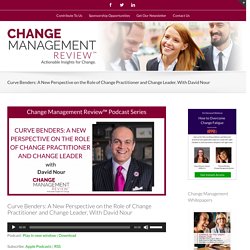
Leading under pressure. Pressure is a goad.
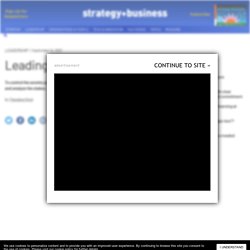
Whether it arrives in the guise of a burning platform or a project deadline, a strategic goal or a performance target, a high-stakes deal or an aggressive competitor, pressure can help leaders attain new heights of performance and achievement. You know the adage: no pressure, no diamonds. The problem with this pithy observation, attributed to 19th-century Scottish essayist Thomas Carlyle, is that it is both true and false.
Leadership Clarity and Consistency. Future of leadership depends on creating ecosystems of engagement. Leaders need a new playbook for the “next normal.”
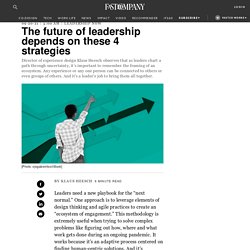
One approach is to leverage elements of design thinking and agile practices to create an “ecosystem of engagement.” This methodology is extremely useful when trying to solve complex problems like figuring out how, where and what work gets done during an ongoing pandemic. It works because it’s an adaptive process centered on finding human-centric solutions. And it’s inclusive. Change Management Behaviour: Leadership of Change® Volume 6 (30 September 2021) by Peter F. Gallagher. How leaders can adapt to a different future. The 7 attributes of great change leaders. I’ve been thinking a lot about “What does it take to be a great change leader?” And I’m thrilled to see that more and more executives are actively asking this question and looking at how to develop themselves.
Often, when we think of the qualities of an ideal change leader, we think of terms such as bravery, courage, vulnerability, integrity, authenticity, insightful, transparency, connector, and gratitude. While it is possible to find people in change leadership roles who possess all of these attributes, I think it’s more useful to think about them as part of the composition of a leadership team. So, I’m flagging the importance and value of an executive team that share these attributes, rather than placing all hope in finding, or being, “the one”. It’s worth noting this list of leadership attributes deviates from the ones we commonly recruit for or promote, such as business acumen, operational, or strategic expertise. 1.
On leadership awareness. Case Study: Leading Change Through Unprecedented Times (2021) Leading Change Beyond Lockdown: Three Essential Skills. Leading Change Beyond Lockdown: Three Essential Skills I’ve been busier than ever over the last two years.
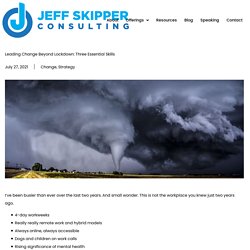
And small wonder. This is not the workplace you knew just two years ago. 4-day workweeksReally really remote work and hybrid modelsAlways online, always accessibleDogs and children on work callsRising significance of mental healthNew hires who have never met their peers face-to-face. Are You a Boss or a Leader? Being the boss does not necessarily mean you are leading. Here are 10 characteristics that will help you determine if you are having a positive impact on your employees. A boss knows it all; a leader is always learning.A boss gives answers; a leader seeks solutions.A boss talks more than listens; a leader listens more than talks.A boss directs; a leader coaches.A boss criticizes; a leader encourages.A boss identifies weaknesses; a leader identifies natural gifts.A boss is all about “me;” a leader is all about “we.”A boss places blame; a leader takes accountability.A boss protects her ego; a leader reveals her vulnerability.A boss demands results; a leader inspires performance.
Every team has a boss, but they really need a leader. Contact us to discuss how you can lead the way to healthy employee and business growth. Lead Better by Knowing When to Follow. Wharton@Work In a leadership rut? Having trouble getting others — even yourself — motivated? According to Greg Shea, adjunct professor of management and senior fellow at Wharton’s Center for Leadership and Change Management, you’re probably defining your role too narrowly. “The common perception of the leader is the lone actor. It’s focused on the individual. It’s an obvious point, but leaders need followers. Adaptable: How to Lead with Curiosity, Pivot with Purpose, and Thrive through Change (14 September 2021) by Alexa Carlin. The future of leadership: Five priorities for CEOs. Special Report What matters most? Five priorities for CEOs in the next normal Download this collection of insights on the five priorities global executives have told us they're focusing on as they navigate the trends shaping the future.
Over the course of the pandemic, businesses have largely—and often successfully—adapted to new ways of working. They’ve also embraced digitization and reorganized their supply chains. Podcast: ‘How To Lead and Manage Change in a Changing World’ with Caroline Samne and Yvonne Ruke Akpoveta. CHRO perspectives on leading agile change. Over the past year, McKinsey convened a series of conversations with chief human resource officers (CHROs) from Europe and Asia–Pacific to explore their organizations’ emerging agile working practices in the context of the COVID-19 pandemic.
These leaders represent companies from a wide range of sectors (telecommunications, banking, retail, and insurance) and at various stages of their agile transformations. Nonetheless, they shared similar HR challenges during the stress test of the pandemic. A consensus view emerged that agile approaches and techniques proved essential amid these new and difficult circumstances.
However, at times, leading agile change can also be a fraught process. The pandemic’s impact and the shift to remote work All participants agreed that the COVID-19 pandemic created tough challenges related to their way of working. LinkedIn by The Change Leadership. On the three C leadership model. Leading Through Change with Harvard Business School Professor John Kotter. Collection on leading change. What it means to be a Human leader. Talk to some CEOs, and it becomes clear that lockdowns imposed by COVID-19 tore down barriers between them and their workforce. One leader I know was taken aback by the response he got for a casual reference to “all 8,000 of us” in an all-hands Zoom call. Leadership With LUV: Lessons From Southwest Airlines' CEO. Gary Kelly CEO and Chairman for Southwest Airlines. Reimagining organisational change leadership (2016) Leading in the New Reality. A new role for business leaders: Moral integrator.
Claire was looking forward to the long holiday weekend. After two brutal weeks of late nights and early mornings getting ready for a new product launch, dealing with supplier disruptions in China, and managing a sudden labor shortage in Germany, the Fortune 500 CEO was ready to catch her breath and spend some quality time with her family. The plan was to leave first thing Saturday morning to beat the traffic headed to the shore. The Inner Game of Change: Change. Leader. 5 Great Habits of Informal Leaders Who Don’t Have a Fancy Job Title. Podcast: Change. Leader - With Dr. Jen Frahm.
Change Leaders, Do You Have Authority on Your Side? Do you have a primary sponsor named for your project but lack the true sponsorship support you need to succeed? When project leaders and change practitioners are asked to name the number one factor in project success, they typically know the answer: active and visible sponsorship. In all of Prosci's Best Practices in Change Management research reports, active and visible sponsorship ranks as the top contributor to project success and has been cited four times more often than any other factor. 3 Must-Follow Rules of Ethical Leadership.
Ethical leadership means different things to different people, but when you apply your ethics properly – and when your ethics align with those of your employees – you can become a more likeable and successful manager. Since leadership and management quality can dramatically impact metrics such as employee engagement, job satisfaction, and employee retention, manager should do everything they can to improve their leadership skills. Three Styles Of Effective Leadership. Mike McMullen is the CEO of Prominence Homes and the author of Build. Rent. LinkedIn by The Change Leadership. How To Lead Change From Anywhere.
How To Start Being More Vulnerable. » L’erreur que tout le monde commet sur la conduite du changement. Le magazine Management Le 11/07/2019 © Heritage Images/Getty Images. Leading Beyond Change: A Practical Guide to Evolving Business Agility (3 August 2021) by Michael Sahota and Audree Tara Sahota. A key mistake leaders are making is causing the Great Resignation. Here are 3 ways to fix it. Leadership by Bernard Burnes, Mark Hughes and Rune Todnem By. What Makes A Good Manager and Leader? The cost of a bad manager amounts to billions of dollars each year. Hundreds of millions of dollars are being spent to measure and improve the employee experience by focusing on the collective organizational experience. However, DecisionWise research shows that organizations should refocus their efforts and double down on their managers.
While creating an environment where employees can both learn and choose to be engaged, our research shows that an engaged manager is 213% more likely to have an engaged team and industry research shows that managers account for at least 70% of the variance of employee engagement scores. The data is crystal clear. Organizations should focus on creating effective managers to improve the employee experience and drive employee engagement.
"Change Leadership is skill for everybody; across every level of the organization" - Yvonne Ruke Akpoveta. 2021 Priorities & The Need for Compassionate Leadership. Leadership by Bernard Burnes, Mark Hughes and Rune Todnem By. A Surprising Habit of Great Leaders. Conduite du changement - Transition numérique et managériale, comment faire bouger mon réseau ? 10 Leadership Habits of Highly Effective Leaders. According to 140 Of The World's Top CEOs These Are The 6 Trends Shaping Leadership Through 2030 and Beyond. In search of good leaders during uncertain times. LinkedIn by The Change Leadership. CIPD Podcast 173 - Embracing and leading organisational change. Course: Agile Change Leadership Certificate: Self-paced.
How To Navigate Leadership During Times Of Change. LinkedIn by Yvonne Ruke Akpoveta. LinkedIn by The Change Leadership. LinkedIn by The Change Leadership. Tips for leading people at a distance. Change management hack: Getting leadership support for change. How To Be An Inspiring Virtual Leader. John C.Maxwell’s 5 levels of leadership. Tips for leading people at a distance.
Podcast: Executive Presence—Do You Have It? Podcast: Crucial Life & Leadership Lessons From Sébastien Bazin, CEO of Accor. It's Time to Stop Celebrating Charisma. Build Your Reputation as a Trustworthy Leader. Podcast: Engaging Leaders During Change with Tim Creasey. Poscast: Former Washington Post Top Editor on Leading Through Change. Harvard Business Review. 7 Ways Leaders Can Show Support To Their Remote Team. Leadership lessons from the Royal Navy. Leading with Feeling: Nine Strategies of Emotionally Intelligent Leadership (7 July 2020) by Cary Cherniss and Cornelia Roche. Leadership Challenges in Managing Organisational Change: Transforming Organisations (15 June 2021) by Dr.E.J Sarma. Report: Methodology - Return on Leadership® Leading Change Processes for Success: A Dynamic Application of Diagnostic and Dialogic Organization Development (29 May 2021) How to Lead in the Stakeholder Era. The Best Use of a Leader’s Time. 5 Areas that Deliver 10x Results.
How are you growing in your journey as a change leader? LinkedIn by Adelaide Denison via Gail Severini. To Be Honest: Lead with the Power of Truth, Justice and Purpose (25 May 2021) by Ron A. Carucci. Compared: the Role of Supervisor vs. the Role of Leader. The Competencies and Constraints That Determine Leadership Success. Why Highly Esteemed Leaders Are Surprisingly Likely to Fumble Their Next Project. 9 Requirements for an Effective Change Leadership Strategy. Your Leadership Operating System: Ego Or Eco? 10 top skills of the best transformation leaders. Excellence Now: Extreme Humanism (15 March 2021) by Tom Peters. 6 Leadership Paradoxes for the Post-Pandemic Era.